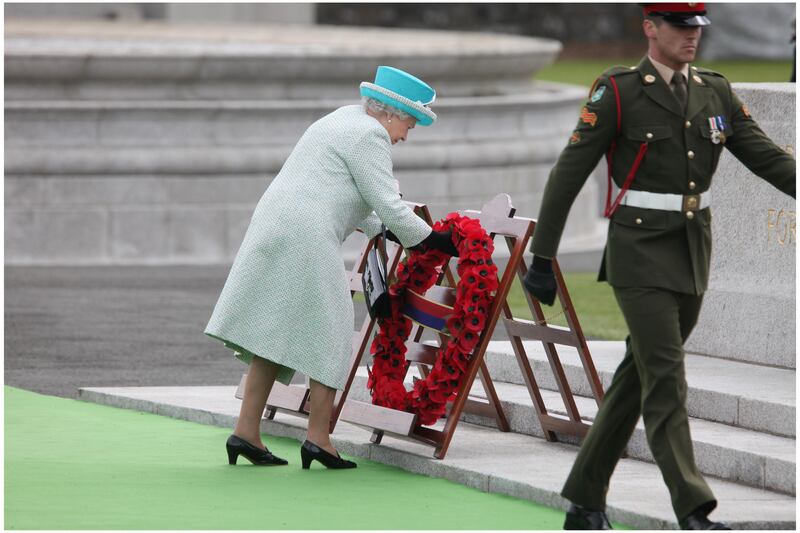One of the breathtaking moments during Queen Elizabeth’s state visit to Ireland in 2011 was when the Irish military officer inviting her to inspect the guard of honour at Áras an Uachtaráin stood directly in front of her and, in the traditional military manner, barked “Banríon Éilis a Dó”.
There are three reasons for the Irish people to mourn the death of Banríon Éilis a Dó. First, she was the head of state of Ireland’s nearest neighbour with which we share so many interests and responsibilities. Second, she won international admiration, including here, for the exceptional dignity and commitment with which she served her country throughout her long reign. Third, she made an immense personal contribution to building the modern friendship between the UK and Ireland.
It was my privilege, as Ireland’s ambassador in London at the time, to be involved in and to accompany the queen on her state visit in 2011, the first such visit by a British monarch to an independent Ireland.

The visit, of course, had to be approved and managed by the London and Dublin governments. But Queen Elizabeth was no mere chess piece in the relationship between the two governments. She was, with then president Mary McAleese, the driving force behind both the preparation and conduct of the visit.
READ MORE
Substantive significance
For several decades, two things had made possible a deepening of the friendship between Britain and Ireland: our shared membership of the European Union and our joint work in bringing peace to Northern Ireland. When I took up my post in London in 2009, it was clear that the queen was determined to take the last symbolic step, a step with substantive significance, towards normalising relations between our countries. She dearly wanted to visit Ireland. Her enthusiasm was expressed to me and many others. She made clear through her officials that she was willing to envisage a far shorter lead-in period than would normally be required for a state visit.
The conception and conduct of the visit were flawless from beginning to end. While the exceptionally close co-operation between the British and Irish authorities played a large part in that, the two heads of state were central to the success of the visit. The queen’s manifest dignity throughout the visit, her respectful bow as she laid a wreath in honour of those who died for Irish freedom, her thoughtful speech at the dinner in Dublin Castle including her unexpected words in Irish, and her palpable enthusiasm for Ireland were deeply appreciated at the time and will never be forgotten.
In more recent years, British-Irish relations have been going through a very difficult period. At least the mood music seems to have improved somewhat since Truss took office. The Irish Government and the EU institutions have rightly flown their flags at half-mast in the queen’s honour. However, relations could deteriorate further if trust is not soon restored.
Deep friendship
Whatever happens, Queen Elizabeth’s personal contribution and legacy will continue to serve as an important calming anchor in the relationship between these islands. Despite the antics of the Boris Johnson years, the impact of her visit to Ireland endures. It continues to remind us that the friendship between our peoples runs deeper than political playacting. Notwithstanding the ongoing divisions in Northern Ireland, Britishness and Irishness, in the broad sense, were reconciled forever by the laying of wreaths in the Garden of Remembrance and at Islandbridge in 2011. It is a measure of historical progress that, these days, any negative feelings in Ireland towards our neighbour relate to Johnson’s unnecessarily hard form of Brexit, and its ongoing consequences for this island, rather than to the grievances of history.
The queen’s personal popularity in Ireland is on a similar scale to the affection in which she is held by the British public. She won many Irish hearts and minds, especially during her historic visit. At the same time, the obvious warmth of the welcome extended to her by everyone in Ireland significantly increased the warmth of the British public towards Ireland. A mere mention of her visit in my speeches in London was greeted by spontaneous applause.
Her successor, Charles III, shares his mother’s affection for Ireland and her determination to deepen relationships across these islands. That may also be counted as part of her legacy. Charles remarked on a visit to the Irish Embassy in London that, every time he has been with Irish people, he comes away with his spirits lifted. It would be nice to think that some of that royal positivity will rub off if, as reported, Liz Truss makes an early visit to Dublin.
When I bumped into Seamus Heaney before the dinner in Dublin Castle during the queen’s visit, I asked him about of his famous lines “Be advised, my passport’s green/No glass of ours was ever raised/To toast the Queen”. He confirmed that, of course, he would drink to her health. As we in Ireland join our British friends in mourning the passing of an exceptional woman, we should likewise raise our glasses in memory of Banríon Éilis a Dó and to her lasting contribution to British-Irish friendship.
Bobby McDonagh is a former Irish diplomat and was ambassador to the UK from 2009 to 2013









